The Continuing Saga of Barn Swallows and Black Rat Snakes

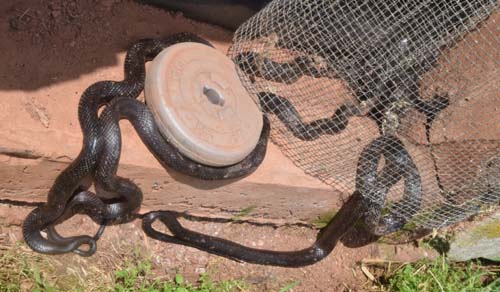
The phoebes and swallows do not interact with one another, even during busy feeding times. In previous years, phoebes and swallows have occasionally nested within 4 feet of each other. The phoebes are cautious in approaching the nest, making several stops along the way, and then quickly feeding the nestlings, remaining at the nest only 3 or 4 seconds. The barn swallows are much more relaxed, often waiting after feeding to receive a fecal pellet or even hanging around for several minutes, seeming to be admiring their progeny. But, during prime feeding times, the male and female arrive together, quickly delivering their prey and flying off together. In the evening, they often scoop up enough insects right in the barnyard and continually fly to and from the nest, making sure that everyone’s belly is full before darkness sets in. Then, the big brown bats take over. The bats, always first, upon leaving the barn, head for the creek, but later, spend hours in the swallow room. They assemble in a group to roost on the side of a specific joist. The largest numbers of bats are present from 10pm until 5:30am. During this time, individuals will occasionally fly off to catch one of the many moths flying about the room and then quickly return to their night roost. I had no idea how much time the bats spend resting or sleeping during the night until one of the swallow nest cams recorded their night roost in the background. This roost was also on one of the smoothly planed joists. It appears they are not intimidated by the black rat snake. In 23 nights of video recordings of their roost site in August, no snake appeared. And, unlike swallows, the bats are not disadvantaged by darkness.


May 27-29 A cardinal nest hidden behind vines on the milk shed wall was predated, most likely by a black rat snake. I had observed the female cardinal leaving the nest location several times, but could not see into the nest itself without disturbing the vegetation. However, carefully slipping a cell phone through the vines enabled photographing the nest and its three young occupants. A video camera was set up to monitor the site, but even the return of the cardinals was not recorded since they entered off to the side and were also completely hidden by the vines. Video recording was discontinued and the nest was checked each day using the cell phone. Three nestlings were present on May 27, two of these were missing the next morning and the third was taken the night of May 29. A black rat snake could easily have reached the nest by climbing up the wall without disturbing the vines or the nest. Visually detecting the perfectly hidden nest would have been completely unnecessary for the snake.
July 2019 - Both barn swallow pairs renested for second broods. Each pair used a different nest cup for the second brood. One pair moved to the rear of the room, laying 5 eggs. The other pair moved to a cup within 8 feet of their first nest in the front of the room and laid 4 eggs.
July18 - A female black rat snake was caught in netting at another swallow room door. There were ten eggs under the snake plus two not yet expelled. I placed the twelve eggs in a container and carefully covered them with damp saw dust. They were left in the swallow room where the temperature is fairly constant, but likely too cool. However, this is apparently where the snake intended to deposit them. The sawdust was kept moist during incubation.
July 19 - The barn swallow nest with 4 eggs was predated. All 4 eggs were gone. No doubt, a black rat snake was the culprit.
July 20 - An infrared lighted camera and DVR were set up for 24 hr monitoring of the remaining barn swallow nest with 5 eggs. The very first night, a black rat snake climbed the rubble wall twice to reach the joist where the nest was located, but did not venture out on the joist toward the nest. It appeared to be unable to cling onto the smooth surface of the joist. The female swallow instantly flew off in the dark, obviously aware of the snake. Luckily, this nest cup is mounted on a smooth and square joist. Many of the joists are sawn flat only on the top and have rounded and rough surfaces on the sides, allowing a snake to wedge itself between the rounded side and the floor boards above.
Aug 13 - A black rat snake again attempts to reach the swallow nest from the rubble wall and again cannot negotiate the smooth sides of the joist. Now the nest has 5 nestlings almost ready to fledge. Later in the night, the snake reaches the nest from the opposite side. Even though the joist was smooth and flat, an electric wire running along the other side of the joist allowed the snake to move out along the wire and coil around a lamp fixture close enough to reach the nest. One nestling was grabbed from the nest and the others fledged into the dark. They were observed being fed the next morning. For a second brood, 4 out of 5 fledging is not bad. Was the snake’s approach from the opposite end and opposite side of the joist and then coiling around the light just dumb luck? Or, did the snake have a plan?
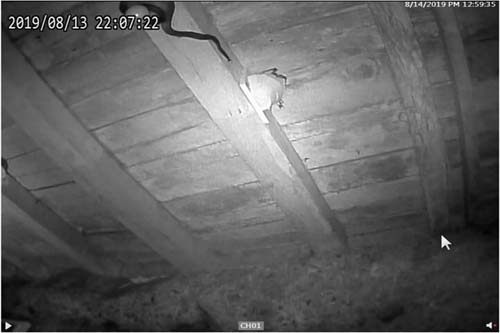

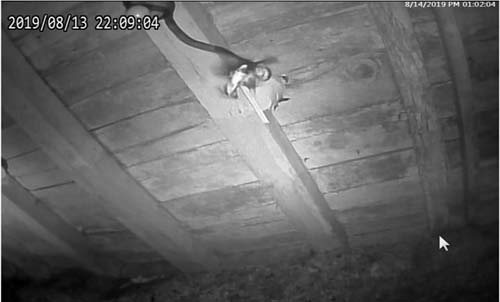
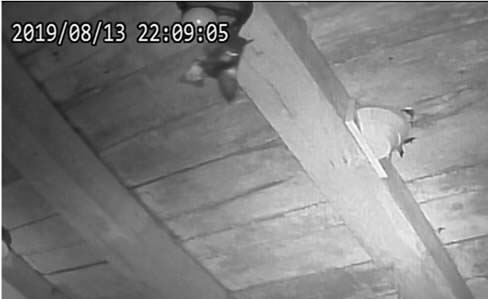
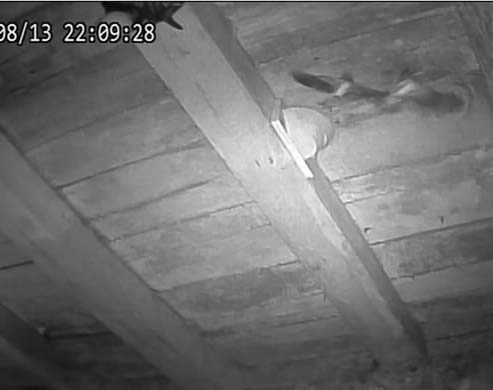

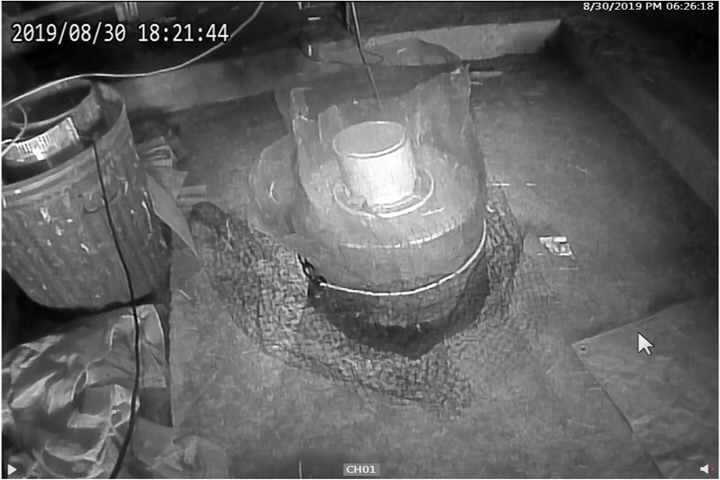
Sept 8 – A large black rat snake was caught in netting under the front porch.
Oct 12 – one of the snake eggs collected on July 18 was opened for inspection It was grossly underdeveloped and long past normal hatch date.
Oct 25 ¬– While priming the oil furnace fuel line in our basement, I happened to notice a section of a black rat snake’s body protruding from insulation that had been stuffed between the joists along an outer wall. It was slowly moving, apparently bothered by my noise. After I finished closing off the fuel line, I looked up again and the snake was out of sight, leaving only the two small holes in the insulation where it had moved out and then back in again.
Dec 22 – I finally checked the basement for the snake seen earlier. It was not behind the insulation. A 3 inch wide space behind the log sill ran the entire length of the wall except at the chimney. Using a video inspection camera with a 30’ reach, I was able to check this otherwise inaccessible space along the wall and around the corner to the front wall. Although I could not see any opening to the outside, there likely is one. Years ago, when I had run an electric wire out this wall and under the front porch, I found several groundhog holes under the porch which I now realize might be ideal snake hibernation sites. A black rat snake was trapped under the porch both this year and last. Also, I could not check half of the front wall with the video camera because the interior was plastered up to the floor boards. There are many perfect options for a hibernating snake and, likely, many more that I have not found. The snakes are welcome in the basement, just not in the swallow room.